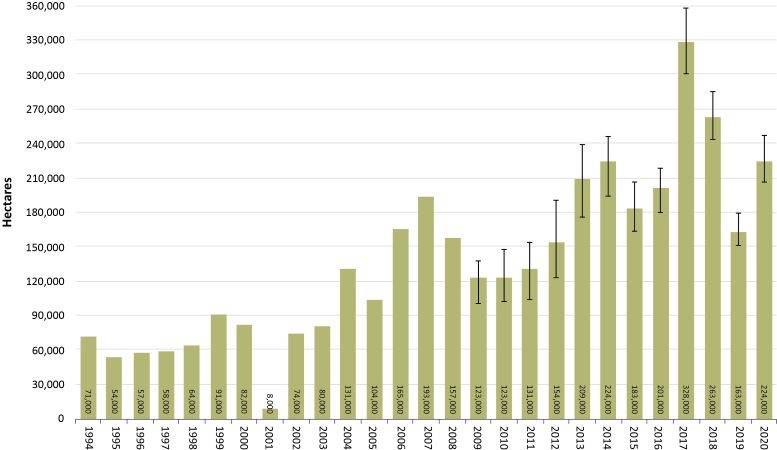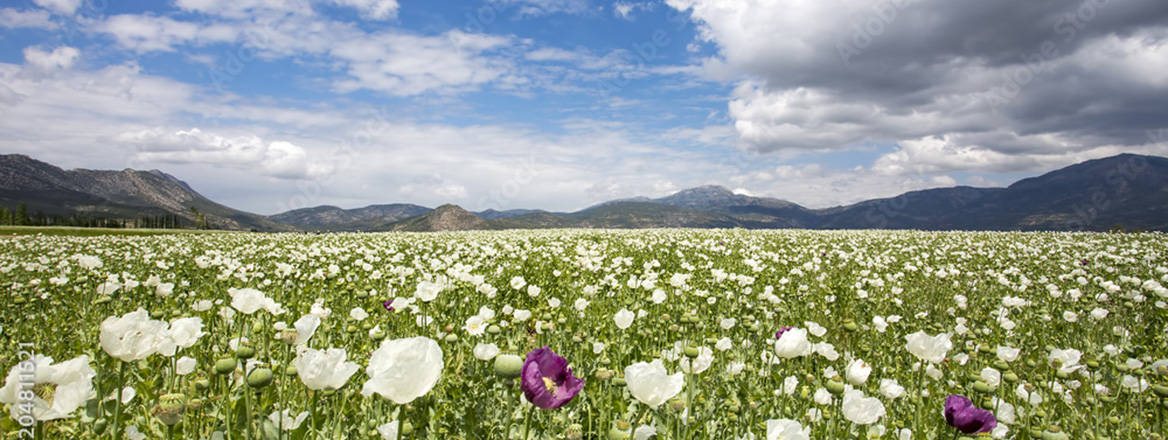Failure to address or even erode the drug trade in Afghanistan has significantly contributed to the country's perpetual instability.
The old saying that ‘success has many fathers, but failure is an orphan’ is, of course, centuries old, but it may require revision in the Afghanistan of 2021 – for the country’s long-standing security issues can lay claim to multiple parentage. One key ingredient is Afghanistan’s drug trade, which has generated an economy reliant on narcotics and foreign aid, guaranteeing weakness in the face of a determined insurgency supported by almost unlimited drug money.
Land of Blood and Money
Afghanistan’s calamitous recent history has been an essential component in its transition from a rudimentary civil–political economy pre-1979 through to the drug economy of today. The breakdown of government control during the Soviet occupation and subsequent civil war, and the physical destruction of land, livelihoods and mass displacement that resulted, encouraged an economic climate just as fertile as the physical one for exploiting opium cultivation and export.
At first this was a convenient source of finance for the mujahedeen opposition to the Soviets, supplementing CIA and Saudi funds funnelled through Pakistan’s Inter-Service Intelligence. However, as the mujahedeen morphed into different interest groups, warlords and war entrepreneurs in the post-Soviet struggle for power after 1992, the drug trade became a key source of funding for their military efforts. Afghanistan was flooded with money, weapons and violence, as civil war completed the destruction of any remaining civil economy and development projects. With the Taliban takeover and enforced peace from 1996, there was little conflict for the war economy to sustain, but the drugs industry that had supported the fighting continued and became one of the primary foundations for economic activity.
Western intervention in 2001 may have stabilised Afghanistan to a degree, but only enough for drug-trafficking networks to consolidate themselves. They took advantage of a ‘Goldilocks zone’ for criminality, where security was not strong enough to enforce the rule of law, but neither was it so dire that anarchy was an impediment to trafficking. Added to this, the smuggling routes along the porous Afghan–Pakistan border left over from the Soviet war continued to be just as viable.
Reaping the Devil’s Crop
The opium paste that is the precursor to heroin is extracted from the unripe seedpods of the opium poppy. The plant is ideally suited to cultivation in Afghanistan, for it requires little water and is tolerant of drought. Such survivability has long been a boon to those farmers who lack the right fertile and socioeconomic conditions (ready workers, access to markets, and so on) to cultivate alternative cash crops on a sustainable scale. According to a report by the UN Office on Drugs and Crime (UNODC) and the World Bank, although opium cultivation does not dominate every district, where it does occur, 70–80% of available agricultural land can be devoted to poppy growth.
In most cases opium is merely a commodity that the farmer will trade away or use to pay for debts that provide seeds, fertiliser and other goods in advance. Traders can be sources of this credit or can simply provide cash for opium or direct bartering in exchange for foodstuffs. Above the traders are the drug traffickers, who are responsible for the movement of opium to heroin-processing labs, often in the volatile Pakistani border regions or security vacuums in Afghanistan itself. At the apex of the pyramid are the key traffickers, several dozen powerful individuals who possess significant wealth and political connections. Ultimately, endemic institutional corruption pervades all levels of Afghan society, government and security forces.
Narco-State of Mind
The spread of the drug trade has been facilitated by the traditional hawala (‘transfer’ in Arabic) system, essentially an Islamic version of Western Union. Its informality has been key to deepening and widening Afghanistan’s informal economy and the laundering of drug money, to the extent that at certain times of year in certain districts, 100% of hawala liquidity can be drug-related. Additionally, a World Bank document found that, only a few years into the post-Taliban era, drug money was finding its way into the legitimate economy by boosting aggregate demand for non-durable and durable consumer goods, real estate and building construction. The result was to embed Afghanistan’s economic dependence on the narcotics trade from the earliest days of international involvement in the country.
According to the UNODC’s World Drug Report 2021, the number of opioid users worldwide has nearly doubled since 2010. Almost 31 million people used either heroin or opium in 2019, representing a huge and growing market for Afghan-produced opioids. In 2018, even following a large drop in value, the opiate economy was still worth between 6–11% of Afghan GDP and exceeded the value of the country’s officially recorded licit exports of goods and services. The recent Afghanistan Opium Survey found that the total ‘farm gate’ (unprocessed and non-transported) value of opium production in 2020 was estimated at $300–400 million, following a 37% increase in area given over to poppy cultivation.

Processing opium into heroin is where the real money is, however. Most Afghan opiates transit into Europe via the so-called Balkan Route through Iran, Turkey and Southeast Europe. In recent years, the estimated value of trafficked opiates along this route alone is $28 billion per annum. Even a small percentage of this amount finding its way into insurgents' coffers (by providing protection to traffickers or participating in trafficking themselves) provides a means for continuous procurement of weaponry, supplies and payment of recruits.
Dragon’s Teeth
Doctrinally, an attempt is made to target an enemy’s centre(s) of gravity, be it leadership, industrial base, military facilities, and so on. A key centre of gravity for any insurgency in the modern world is finance. Forced and voluntary coca eradication campaigns in Colombia were intended to deprive the Revolutionary Armed Forces of Colombia (FARC) of a ready source of funding. Likewise, the targeting of Islamic State oil and gas infrastructure in Syria was designed to erode its economic base. To be sure, aerial bombardment of opium fields has been practiced, as well as (unfortunately faltering) attempts at alternative development, but it has been an incredibly complex and intractable task to conclusively address the narcotics issue.
Afghanistan’s social and economic reliance on the drug trade, as described above, is a major factor. Discouragement of poppy eradication, whether due to endemic corruption or genuine concern over the potential rural backlash, is another. Proper resource allocation, training and institution-building also feature. Colombia, for example, employs tens of thousands of dedicated counter-narcotics personnel, supported by decades of US-backed funding and mentoring. In Afghanistan, by contrast, despite the activities of small but efficient special counter-narcotics police units, the interdiction budget actually fell from a peak of $627 million in 2010 to approximately $138 million in 2017. In addition to this, the February 2020 Doha peace agreement precludes aerial bombing of opium/heroin depots, labs and transportation trucks, further undermining any aggressive counter-narcotics effort.
The link between insurgent effectiveness and financing cannot be understated. Research on civil war duration by James Fearon found that those fuelled by contraband can last an average of close to 50 years, five times longer than conflicts that are not. This allows insurgent groups the luxury of strategic patience as long as they have access to such resources. This perhaps explains the geographical correlation between areas of high drug cultivation and recent Taliban gains, as the insurgency not only expands its territorial control, but also consolidates its hold over a primary source of funding and centre of gravity.
Graveyard of Good Intentions
Afghan and international authorities have faced a catch-22 situation. In the absence of huge and coordinated alternative economic development efforts, properly tackling the drug trade would have likely precipitated economic depression, rural insurrection and state breakdown, so entwined is it in the social fabric of the country. However, the unchecked growth of the drug trade has created a brittle state and provided unlimited funding for insurgent operations, precipitating the very rural instability it was hoped would be avoided.
The short to medium term consequences are concerning from a human security perspective. Regional crises in public health will increase, as levels of drug addiction grow in Iran, the Central Asian republics and Afghanistan itself. An Afghan economy reliant on illicit trade will never be free of corruption, while meaningful development will be continuously stymied. Most worryingly, vast opium cultivation potential will endure beyond the latest security developments on the ground. Coupled with a growing global market for opiates, especially in low-income countries, it is highly likely that terrorist groups who do manage to base themselves or have branches in Afghanistan will have ready access to funds for their operations. The blood-soaked Afghan soil could prove just as fertile for the flowering of regional and international terrorism as it is for the opium poppy.
The views expressed in this Commentary are the author’s, and do not represent those of the Ministry of Defence or the UK government, nor of RUSI or any other institution.
Have an idea for a Commentary you’d like to write for us? Send a short pitch to commentaries@rusi.org and we’ll get back to you if it fits into our research interests. Full guidelines for contributors can be found here.


